
Leonardo’s aim is to support the ESA by defining a state-of-the-art security monitoring system for Galileo, taking into account new mission requirements and new security standards and procedures relevant to the European satellite network.
“The cyber security of Space infrastructure is more critical than ever before. New technologies must be developed – including via international collaborations – to protect satellite-based assets, which have become a crucial part of the daily lives of citizens and play key roles in critical national infrastructure, from communications to transportation and defence. Protecting them against cyber threats has become essential”, said Alessandro Profumo, CEO of Leonardo. “Therefore, we are proud of this collaboration with the ESA that will enable us to enhance our cyber security expertise in the cutting-edge Space sector”.
Galileo, which started delivering services in December 2016, is managed by the European Commission, which has delegated the technical development and deployment of infrastructure to the ESA. Galileo will provide reliable and accurate services for citizens, transport, telecommunications, security, emergency management, search and rescue, companies, banks and utilities. Leonardo has been a key industrial partner throughout the life of the Galileo programme, providing operational and logistical management from Telespazio, through Spaceopal, focusing on the development of innovative services, especially for government customers and operators with special security requirements, who will use the Galileo PRS signal. Leonardo also provides the attitude sensors which control the position of the satellites and the hydrogen atomic clocks that accurately mark the time, as well as a receiver for PRS services.
